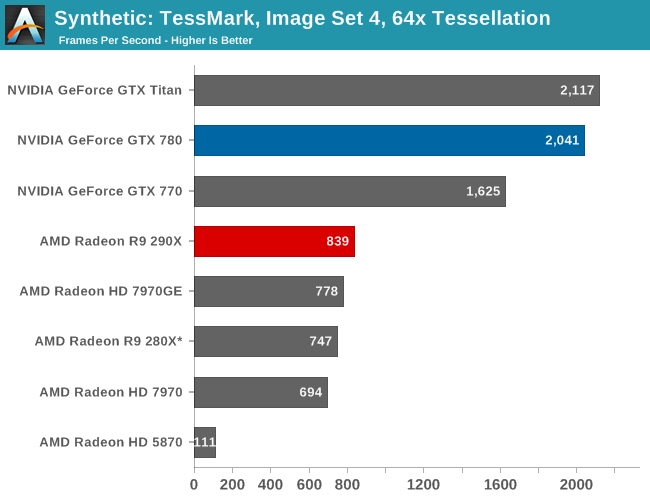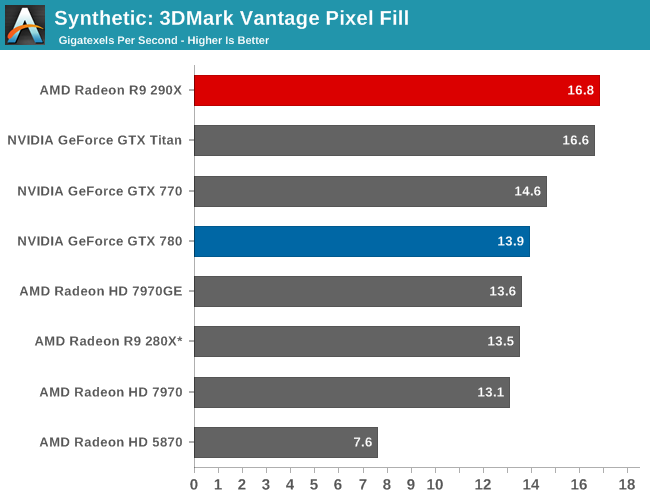The AMD Radeon R9 290X Review
by Ryan Smith on October 24, 2013 12:01 AM EST- Posted in
- GPUs
- AMD
- Radeon
- Hawaii
- Radeon 200
Synthetics
As always we’ll also take a quick look at synthetic performance. The 290X shouldn’t pack any great surprises here since it’s still GCN, and as such bound to the same general rules for efficiency, but we do have the additional geometry processors and additional ROPs to occupy our attention.

Right off the bat then, the TessMark results are something of a head scratcher. Whereas NVIDIA’s performance here has consistently scaled well with the number of SMXes, AMD’s seeing minimal scaling from those additional geometry processors on Hawaii/290X. Clearly Tessmark is striking another bottleneck on 290X beyond simple geometry throughput, though it’s not absolutely clear what that bottleneck is.
This is a tessellation-heavy benchmark as opposed to a simple massive geometry bencehmark, so we may be seeing a tessellation bottleneck rather than a geometry bottleneck, as tessellation requires its own set of heavy lifting to generate the necessary control points. The 12% performance gain is much closer to the 11% memory bandwidth gain than anything else, so it may be that the 280X and 290X are having to go off-chip to store tessellation data (we are after all using a rather extreme factor), in which case it’s a memory bandwidth bottleneck. Real world geometry performance will undoubtedly be better than this – thankfully for AMD this is the pathological tessellation case – but it does serve of a reminder of how much more tessellation performance NVIDIA is able to wring out of Kepler. Though the nearly 8x increase in tessellation performance since 5870 shows that AMD has at least gone a long way in 4 years, and considering the performance in our tessellation enabled games AMD doesn’t seem to be hurting for tessellation performance in the real world right now.
Moving on, we have our 3DMark Vantage texture and pixel fillrate tests, which present our cards with massive amounts of texturing and color blending work. These aren’t results we suggest comparing across different vendors, but they’re good for tracking improvements and changes within a single product family.

Looking first at texturing performance, we can see that texturing performance is essentially scaling 1:1 with what the theoretical numbers say it should. 36% better texturing performance over 280X is exactly in line with the increased number of texture units versus 280X, at the very least proving that 290X isn’t having any trouble feeding the increased number of texture units in this scenario.

Meanwhile for our pixel fill rates the results are a bit more in the middle, reflecting the fact that this test is a mix of ROP bottlenecking and memory bandwidth bottlenecking. Remember, AMD doubled the ROPs versus 280X, but only gave it 11% more memory bandwidth. As a result the ROPs’ ability to perform is going to depend in part on how well color compression works and what can be recycled in the L2 cache, as anything else means a trip to the VRAM and running into those lesser memory bandwidth gains. Though the 290X does get something of a secondary benefit here, which is that unlike the 280X it doesn’t have to go through a memory crossbar and any inefficiencies/overhead it may add, since the number of ROPs and memory controllers is perfectly aligned on Hawaii.










396 Comments
View All Comments
pattycake0147 - Friday, October 25, 2013 - link
Nope piroroadkill is spot on with speaking his opinion. Anand continually asks for reader feedback, and he's doing just that.The rate at which this article is being finished is piss poor. Ryan said it would be finished in the morning the day of posting which meant in the next 12 hr or so. The main explanatory pages took about 24 hr to be completely fleshed out, and the graphs still don't have any text explaining the trends in performance. I actually value the author's commentary more than the graphs, and looking through a review which is incomplete over 36 hr after posting is much below Anandtech standards.
I hate to bring it up because I like reading the vast majority of content on Anandtech regardless of market or complany, but I firmly believe piroroadkill is correct in saying that a new Apple product would have had a complete and thorough review shortly after NDA was lifted.
HisDivineOrder - Friday, October 25, 2013 - link
He had three R9 290X's in one system. Crossing his chest, he took out his third and slid its PCIe into the test bed. Immediately, the room began to darken and a voice spoketh, "You dare install THREE R9 290X's into one system! You hath incurred the wrath of The Fixer, demon lord of the 9.5th circle of hell! Prepare for the doooooom!"Then the system erupted into flames, exploding outward with rapid napalm-like flames that sent him screaming out the door. Within seconds, the entire building was burning and within minutes there was nothing left but ashes and regrets.
Ever since, he has been locked away in a mental health ward, scribbling on a notepad, "Crossfire," over and over. Some say on the darkest nights, he even dares to whisper a single phrase, "Three-way."
B3an - Saturday, October 26, 2013 - link
LOL!Ryan Smith - Monday, October 28, 2013 - link
Hahaha!Thanks man, I needed that.
yacoub35 - Friday, October 25, 2013 - link
It's a bit silly to list the 7970 as $549 when the truth is they can be had for as little as $200. And they're easily the best deal for a GPU these days.yacoub35 - Friday, October 25, 2013 - link
To clarify: A marketing piece lists "Launch prices", a proper review compares real-world prices.yacoub35 - Friday, October 25, 2013 - link
So double the ROPs on a new architecture and an extra GB of faster GDDDR results in maybe 10-20 more frames than a 7970GE at the resolution most of us run (1920x). Somehow I don't think that's worth twice the price, let alone the full $549 for someone who already owns a 7970.Jumangi - Friday, October 25, 2013 - link
Only a clueless noob with too much money in their pocket would buy a 290x if they are running at 1920 resolution.kyuu - Friday, October 25, 2013 - link
If you're just looking to game at high details on a single 1080p monitor, then no, the 290X isn't interesting as you're spending a lot of money for power you don't need. If you're gaming at 1440p or higher and/or using Eyefinity, then it's a different story.Hulk - Friday, October 25, 2013 - link
I just wanted to thank Ryan for getting up the charts before the rest of the article. We could have either waited for the entire article or gotten the performance charts as soon as you completed them and then the text later. Thanks for thinking of us and not holding back the performance data until the article was finished. It's exactly that type of thinking that makes this site the best. I can imagine you starting to work on the text and thinking, "You know what? I have the performance data so why don't I post it instead of holding it back until the entire article is finished."Well done as usual.